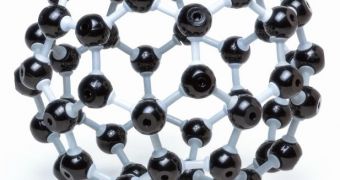Although being the most abundant and lightest element in the universe, hydrogen is one of the most difficult to store in bulk. Take classical gas storage containers for example. The temperature and the pressure inside them must be closely correlated to ensure that the container is able to hold. Maintaining the right pressure is easy, however maintaining temperature is somehow problematic because it requires a input of extra energy. This situation is not ideal, since the main goal followed by most hydrogen powered vehicle developers is to minimize energy consumption and pollution at the same time.
Alternatively, researchers often resort to using hydrogen absorbing substances to maintain a reasonable pressure at normal atmospheric temperatures. One of the latest developed hydrogen storage technique involves the use of carbon capsule which could hold hydrogen at densities close to that experienced in the core of the planet Jupiter.
These so-called buckyballs, have been developed by materials scientists from the Rice University. Research leader Boris Yakobson, professor of mechanical engineering and materials science says that "Based on our calculations, it appears that some buckyballs are capable of holding volumes of hydrogen so dense as to be almost metallic. It appears they can hold about 8 percent of their own weight in hydrogen at room temperature, which in considerably better than the federal target of 6 percent."
The idea of storing hydrogen into molecular containers is not nearly as new as it might sound, and has been previously demonstrated that the method is viable. All Yakobson and his colleagues had to do is find the right material, the one which held the largest volume of hydrogen before giving in under pressure.
Buckyballs have been created for the first time nearly two decades ago, and are part of the fullerene carbon molecules family. According to Yakobson, a typical buckyball is composed of about 60 atoms, while the largest of all can contain more than 2,000 atoms. "Bonds between carbon atoms are among the strongest chemical bonds in nature," Yakobson said. "These bonds are what make diamond the hardest known substance, and our research showed that it takes an enormous amount of internal pressure to deform and break the carbon-carbon bonds in a fullerene."
Computer simulations modeled each atomic bond in a buckyball to reveal what happens when large volumes of hydrogen are pumped inside the buckyballs, thus revealing the true amount of fuel that can be held into a buckyball before the enormous pressure ruptures the structure. Yakobson believes that buckyballs could be mass produced in the form of powders. "They might find use in their whole form or be punctured under certain conditions to release pure hydrogen for fuel cells or other types of engines," Yakobson added.

 14 DAY TRIAL //
14 DAY TRIAL //